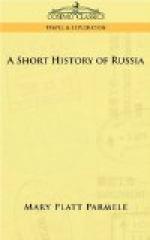The question of succession now became a very grave one. Alexis, who had under compulsion married Charlotte of Brunswick, left a son Peter. The only other heirs were the Tsar’s two daughters Anna and Elizabeth, the children of Catherine. Shortly after the tragedy of his son’s death, Peter caused Catherine to be formally crowned Empress, probably in anticipation of his own death, which occurred in 1725.
CHAPTER XVII
GERMINATING OF SEED—CATHERINE EMPRESS
The chief objection to a wise and beneficent despotism is that its creator is not immortal. The trouble with the Alexanders and the Charlemagnes and the Peters is that the span of human life is too short for their magnificent designs, which fall, while incomplete, into incompetent or vicious hands, and the work is overthrown. Peter’s rest in his mausoleum at Sts. Peter and Paul must have been uneasy if he saw the reigns immediately succeeding his own. Not one man capable of a lofty patriotism like his, not one man working with unselfish energy for Russia; but, just as in the olden time, oligarchic factions with leaders striving for that cause which would best protect and elevate themselves. Menschikof, Apraxin, Tolstoi promoting the cause of Catherine that they may not suffer for the death sentence passed upon Alexis; Galitsuin and others seeing their interests in the succession of Peter, son of Alexis and grandson of the Emperor.
Catherine’s harmless reign was over in two years (1727) and was followed by another, equally brief and harmless, by the young Peter II. The wily Menschikof succeeded in betrothing his daughter to the young Emperor, but not in retaining his ascendency over the self-willed boy.
We wonder if Peter saw his great minister scheming for wealth and for power, and then his fall, like Wolsey’s, from his pinnacle. We wonder if he saw him with his own hands building his hut on the frozen plains of Siberia, clothed, not in rich furs and jewels, but bearded and in long, coarse, gray smock-frock; his daughter, the betrothed of an Emperor, clad, not in ermine, but in sheep-skin. Perhaps the lesson with his master the Carpenter of Saardam served him in building his own shelter in that dread abode. Nor was he alone. He had the best of society, and at every turn of the wheel at St. Petersburg it had aristocratic recruits. The Galitsuins and the Dolgorukis would have joined him soon had they not died in prison, and many others had they not been broken on the wheel or beheaded by Anna, the coarse and vulgar woman who succeeded Peter II., when he suddenly died in 1730.




